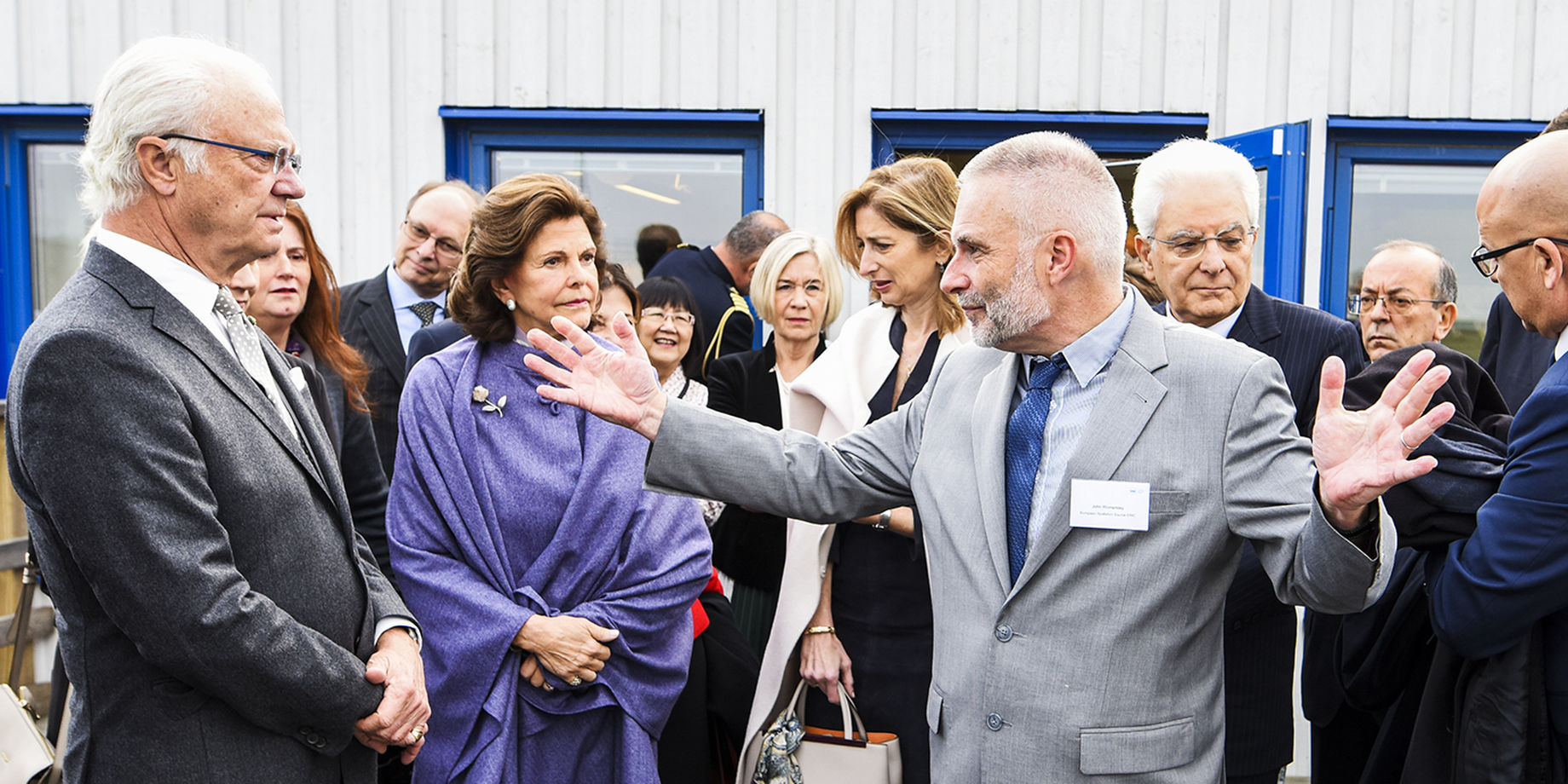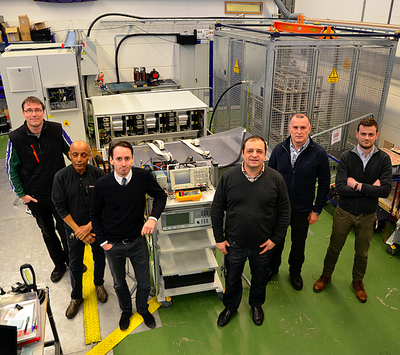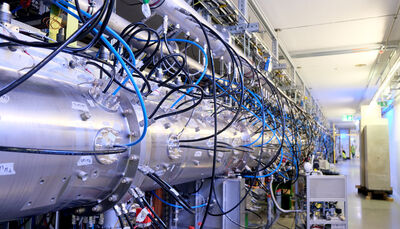
High-level Swedish and Italian delegations, led by King Carl XVI Gustaf of Sweden and President Sergio Mattarella of Italy, came together to inaugurate the first major technical components to be commissioned at the European Spallation Source: the Accelerator’s Ion Source and LEBT.
LUND—Commissioning of the first major technical components of the European Spallation Source (ESS) is underway. The machine was jointly inaugurated by Sweden’s King Carl XVI Gustaf and Italian President Sergio Mattarella in an event held this morning at the ESS construction site. The Italian president is on a three-day state visit to Sweden.
Also in Lund for the ceremony were Queen Silvia of Sweden, Mrs. Laura Mattarella, the president’s daughter and First Lady of Italy, Swedish Minister of Higher Education and Research Helene Hellmark Knutsson, and Ricardo Antonio Merlo, Secretary of State of the Italian Ministry of Foreign Affairs and International Cooperation.
“The relations between [Italy and Sweden] are of great collaboration,” said President Mattarella in a statement to the press on Tuesday at the Royal Palace in Stockholm. “I am pleased that this visit is oriented to retrace many aspects of the advanced technological frontier that Sweden represents. I believe that the collaboration between our countries will develop further in the field of technological advancement and in the application to the business sector of new scientific advancements.”
An Important Step Toward Start of the User Programme
The Ion Source and Low-Energy Beam Transport Line (LEBT) are components of the ESS linear proton accelerator, or LINAC, and were designed, built and delivered as a €4.5 million in-kind contribution from Italy.
Italy is one of the 13 Founding Members of the European Spallation Source ERIC, and is preparing more than €70 million in additional in-kind contributions through their Italian National Institute of Nuclear Physics (INFN) labs in Catania, Milan and Legnaro, the Elettra Synchrotron facility in Trieste, and the Italian National Research Council (CNR). In all, Italy will contribute €110 million to the facility’s construction, covering 6% of the total cost.
ESS Director General John Womersley and Vice President of INFN Speranza Falciano represented the two collaborating organisations at today’s event. Together they gave the large Swedish and Italian delegations a presentation on the anticipated scientific impact of ESS. A media presentation was made by ESS Council Chair Lars Börjesson, Head of the ESS Accelerator Division Mats Lindroos, and Santo Gammino, the Director of Research at INFN’s National Laboratory of the South (LNS), the Sicilian lab where the Ion Source and LEBT were designed and built.
“ESS is a European flagship for science and innovation, built upon critical contributions from partners all over Europe,” said John Womersley. “The commissioning of the Ion Source is a key milestone for the project and demonstrates the excellent collaboration with our Italian in-kind partner INFN-LNS, who have delivered a technological masterpiece to ESS.”
Making the Beam
The Ion Source is the origin of the ESS Accelerator’s proton beam. The beam is accelerated over half a kilometre’s distance to nearly the speed of light, at which point it will strike a heavy metal target to produce neutrons in a process known as spallation. The ESS neutron beamlines will in turn be used for scientific research in support of discoveries in critical fields such as materials science, engineering, sustainable energy, quantum phenomena and medicine.
The LEBT is a machine about two and a half metres in length and is coupled directly to the Ion Source. It passes the beam from the Ion Source to its first stage of acceleration in the Radio Frequency Quadrupole (RFQ). Using strong magnetic solenoids to draw protons out of the Ion Source’s plasma, the LEBT “stretches” them into a beam that can then be matched to the existing beam and characterised for acceleration.
Commissioning of the two components will result in the first proton beam in the ESS Accelerator Tunnel, representing ESS’ most important technical milestone to date. The staged installation of the remainder of the 600-metre-long LINAC will follow, progressively moving the beam toward the Target Station.
“The successful delivery of the Ion Source and LEBT from Catania has allowed Accelerator commissioning and installation to proceed according to plan,” said ESS Technical Director Roland Garoby. “We now begin to look forward to achieving beam-on-target, and producing the facility’s first neutrons. This will enable the commissioning of the instruments, allowing ESS to begin its user programme and early scientific experiments in 2023.”
Italy Provides Model of In-Kind Success
The scale of the ESS in-kind model is unprecedented, and is the first of its kind to be implemented within a Big Science project. Because ESS was conceived as a Greenfield project, with no existing physical or administrative infrastructure in place, it is both necessary and beneficial to lean on the collective expertise across Europe. The ESS collaboration includes nearly 40 European in-kind partners, and more than 130 research institutions participating worldwide.
The largest and most complex of the in-kind projects is the construction of the ESS Accelerator, the most powerful linear proton accelerator ever built. It would have been impossible within the scope of the ESS project to build the infrastructure and recruit the personnel needed to build such a cutting-edge machine. Its construction is therefore underway at nearly 20 institutes across eight European countries, with each completed component to be delivered to Lund for installation.
“The contribution of INFN to the construction of ESS has been crucial because of two important heritages extending from the work done at Catania since the end of the 90s,” noted INFN’s Gammino. “The first is the fact that we have previously worked on Greenfield facilities. The second is our long-standing experience in the construction of components for high-intensity accelerators.”
“The design of the source started in 2012,” said Lorenzo Neri, Deputy Leader of the Ion Source and LEBT Work Unit at INFN-LNS. “It has been amazing to see the coordinated effort of the most expert colleagues of our institution working in collaboration with research institutes like ESS in Sweden and CEA in France.”
Delivery, Installation and Commissioning of LINAC Surges Forward
The work at INFN in Catania, which included testing and local commissioning of the system, was completed in November 2017. One month later, the Ion Source and LEBT arrived in Lund by truck. The equipment was the first to be lowered into the otherwise empty Accelerator Tunnel and its Front End Building. The machine was installed earlier this year. It was the first major installation challenge for ESS, and a process that has been pivotal to developing the installation model going forward.
“The excellent execution of this early and critical in-kind contribution by INFN has set us off on the right foot,” said Lindroos. “We can now look forward to installation of the RF systems and the remainder of the Accelerator’s front-end components. In the coming months we will receive the RFQ from France’s CEA, the MEBT from Spain’s ESS Bilbao, and INFN’s components for the DTL. The warm LINAC units from the UK’s STFC are well into series production, and the testing, commissioning and manufacturing of the Accelerator’s superconducting sections continues in France, the UK and Sweden. We are moving forward quickly now.”




































